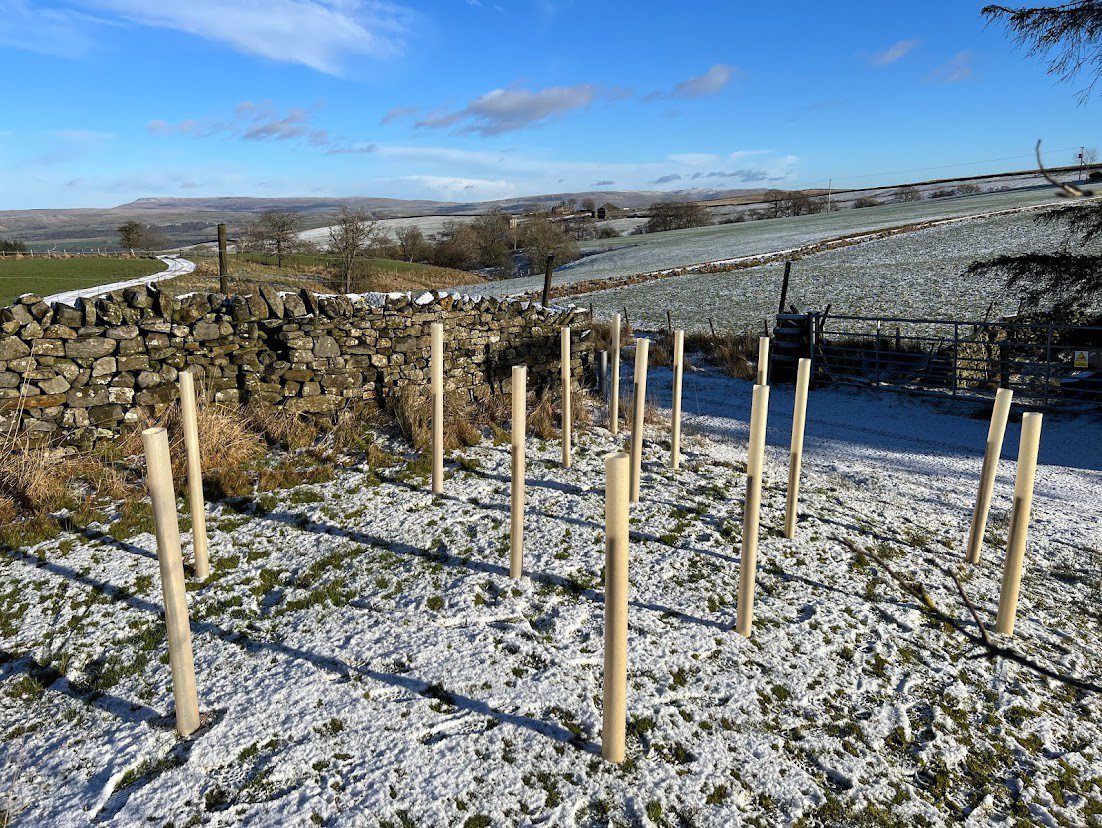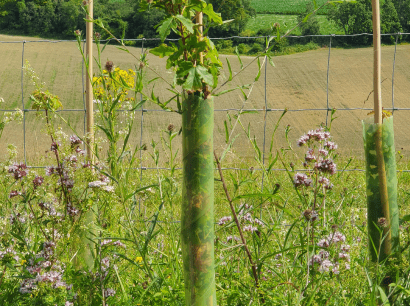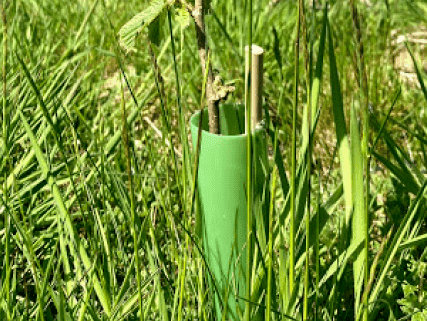Email: info@rainbow.eu.com
Forestry includes the related sectors of Agroforestry, Urban Forestry, broadleaved woodland creation, and commercial conifer forestry. Rainbow has products to suit all these aspects of the industry. Tree and shrub protection is necessary for these environments at various heights due to the presence of browsing animals, such as mice, voles, rabbits, hares, and deer.
Since the mid-1980s, there has been a political push to see more native woodlands, in particular within the UK, which are very palatable to browsing animals. This led to the increased use of individual protection, usually made from plastic. The need for individual protection today is more relevant than ever today due to the increased numbers of browsers and higher tree planting targets to be achieved.

Tree shelters can protect young trees from being damaged or destroyed by herbivores such as deer, rabbits, and rodents. These animals are attracted to the tender bark and leaves of young trees, which can be easily destroyed by their browsing and gnawing.

To successfully establish a transplant, weed control is an important silvicultural task and one of the most successful ways is an annual herbicide application around the base of the tree for the first three years. Spray drift can cause damage and death to a tree via the leaves, so shielding it with a shelter avoids contamination.

Tree shelters can provide young trees with protection from harsh weather conditions, providing the tree valuable time to establish. Tree shelters can also offer protection against the effects of hail stones, often encountered in some countries in late spring.
Woodland creation is often supported by public funds for public benefit and the use of plastic to protect those trees is not harmonious and there is a hunger for bioproducts to be used. The public and the forestry industry are becoming educated in what is a genuine bioproduct and what is greenwashing, which is significant in the bid to have the right certified products in use. Furthermore, a natural FSC-wood-based shelter helps in demonstrating sustainable forestry practices and using truly circular products that support the forestry and wood industry.

Using plastic for protection is counter-intuitive to creating natural woodland. The residue from using an oil-based shelter is contaminating the ground from an early stage and not collecting the residue once the tree is established leaves not only microplastics but larger debris that cannot be recovered. Recycling is not always possible and often only a maximum of 85% is ever recovered from any site. The need for shelter is clear, but in order to reduce the use of plastic we look to the biodegradable option and the solution that gives no microplastic contamination, no waste plastic, and a clean conscience.
Although commercial coniferous forestry does not traditionally use protection, the increasing
incidents of high vole populations in upland sites dictate the need for at least 20cm guards for
each conifer.



Landscaping encompasses a wide range of applications but mainly centres on roadside planting, parks and gardens, and urban tree planting usually in a formal setting and associated with public spaces and recreation.
Tree shelters are vital to promoting healthy tree growth, while also improving the overall appearance and functionality of the landscaping project.



The landscaping sector is not only about a successfully established project, but also the aesthetic impact, and by using biodegradable products, this image sends a positive message to not only the public at large but the authorities and specifiers. Large landscaping projects are often supported or fully funded using public money and the use of responsible protection is in keeping with best practices for taxpayer investment.

The image and presentation in this sector are important and the use of traditional plastic is becoming more difficult. A recycling scheme is a great solution but with an increasingly critical and vocal public, being seen to be using the latest non-plastic biodegradable option is a significant factor in protection choice. There is a range of options from Rainbow for landscaping including the bio shelters and spirals along with recycled options for spirals in a shorter length, but still giving the microclimate for the first year.
Of course, this certification by authorized agencies such as TUV is particularly relevant to ensure products are tested against the right standards and ISO tests and meet their stated function.



Viticulture, like forestry and landscaping, is a worldwide industry and one that is also becoming very aware of sustainability and environmental issues. Young vines need protection for around 3 years after planting to protect against the browsing effects of mice, voles, and rabbits. Deer are usually fenced out at vineyard inception.

Grapevines are sometimes vulnerable to damage from wildlife, such as rabbits. Tree shelters can provide a physical barrier around young grapevines, protecting them from damage caused by browsing.

Tree Shelters in viticulture reduce establishment time by on average 1 year, with obvious interesting economic benefits (based on tests performed in France).

Protection from wind and weather, and reduced competition with weeds are primary reasons why shelters improve vine survival rates. In late spring, when delicate vine buds are prone to frost damage, tree vine shelters also offer a degree of protection.
Traditionally, viticulture operates in a clean and tidy manner with emphasis on presentation and image. The use of vine shelters, although relatively short, is important and the benefits of using a bioproduct are immense as the grapes produced by the vines must be high quality and not have an association with microplastics and litter. The UK Wine industry aims to be sustainable by 2030 by reducing its carbon footprint, protecting biodiversity, and using natural resources responsibly. They aim to be net-zero carbon emissions by 2040 (2023, winegb).


The use of bioproducts helps reduce the environmental impact of viticulture. Rainbow Terra biodegrades in soil, water, and marine environments making sure that no residues remain detrimental.

There is increasing consumer demand for products that are produced using sustainable and environmentally friendly methods. The importance of certification is key in this and using TUV certified biodegradable products is a great reference.
Rainbow Terra is the only genuinely certified tree shelter by TUV Austria (okcompost.org). Bio vine shelters, such as the Terra, are designed to last on average about 5 years, but in viticulture, they are only needed for around 3 years. The Rainbow Terra shelters can be removed when suitable and simply be mulched as the mower passes through. The resulting debris is organic and it becomes soil within 2 years as per the ISO guidelines for soil biodegradability.


The growing of fruit trees and nut trees is susceptible to all the issues surrounding tree and vine planting. Fruit and nut trees need protection for around many years after planting to protect against the browsing effects of mice, voles, and rabbits. In addition, the main stem needs to be sheltered from the sun during the early life of the tree.

Browsing is a problem with mice, voles, rabbits, and hares along with early herbicide spraying to ensure successful establishment. Mice and voles are often a particular problem as they cause damage to root collar area even to older trees.

In countries outside the UK, the concern for fruticulture is the sunlight and heat build-up on the main stem, which is pruned to be devoid of branches to encourage growth in the fruiting area. The stems can be exposed to the sun, causing damage to the cambium layer under the bark, which affects the transport of water and minerals around the tree. By having shelter such as the Rainbow Terra in place, the sunlight is intercepted and dispersed within the shelter wall and the light colour of the Terra reflects heat away from the tree stem making the issue less of a concern for the growers.

The need for a guard, even with older trees, is significant but biodegradable protection still has a place to avoid the use of plastic and the subsequent contamination of the soils. The non-toxic Terra guard can be used to give the required protection while being totally soil degradable.

Biodegradable materials can break down in the soil, leaving no residue and reducing waste. The Rainbow Terra is the only shelter that can prove its biodegradability for soil standards and it has been certified by TUV AUSTRIA (okcompost.org). It can easily be Mulched in the soil.

Biodegradable tree shelters align with sustainable agriculture practices, resulting in increased customer acceptability while using sustainable and renewable resources.

Using biodegradable materials may also improve the image and reputation of a company or farm, as it shows a commitment to sustainability and responsible environmental practices.



Drop in your email for our team to get in touch with you for consultation.
Let us make this world greener together!

131 Cumberland Street Hull, HU2 0PP United Kingdom
Tel: +44 (0) 1482 616861
Email: info@rainbow.eu.com